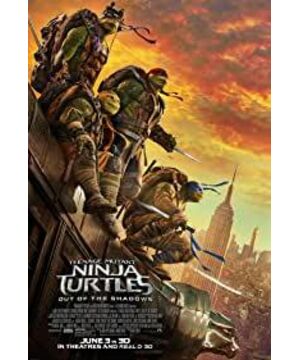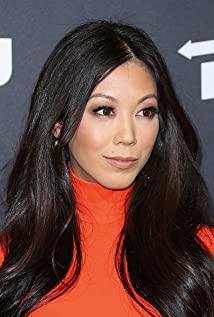Green's feature debut may have been the main reason for him to be hired for Teenage Mutant Ninja Turtles 2. The sci-fi film "Echoes of Earth" was released in 2014 along with Libesman's "Teenage Mutant Ninja Turtles: Age of Mutants." Although it is not a shocking work, it has not only won a good harvest at the box office, but also received positive reviews from the critics. The cunning Lao Bei knew that if there was a bunch of media badmouthing the sequel to the Turtles in the early stage, it would definitely affect the box office. Abandoning Liebesman and using Green is to keep word of mouth. This trick really worked. As soon as everyone saw Green's name, they immediately said: Ah, "Turtle Turtle 2" may be very different, which is exciting!
The truth is: we've all been played by Michael Bay.
= The dynamic capture of childhood destruction =
The plot of "Teenage Mutant Ninja Turtles 2: Out of the Shadows" is not complicated. After being captured in the first installment, the villain Slade escapes from prison this time with the help of Bigfoot and mad scientist Baxter Stockman. Stockman's actor Tyler Perry has suffered repeated defeats as a director, but his production and performance can be considered a strong faction, almost the strongest part of the "Ninja Turtles 2" cast. As a result, he played Stockman not crazy at all, but full of anger, I am afraid that the golden raspberry is promising.
Slade, who was transported to a different dimension, colluded with the alien creature Krona in an attempt to conquer the earth. Collecting the equipment entrained in the three meteorites could open the gate of time and space and introduce Krona's robots to slaughter the earthlings. There is also a blue liquid that can "dig out the animality of human beings" and turn the two villains of Bigfoot into orcs to fight against the turtles.
The rest of the content is a spoiler if you say more, and such a bad movie is not worth watching if it is finished. In short, the main line throughout is that after the scientific turtle Donatello discovered that the blue liquid may turn the four brothers into human figures, the food turtle Michelangelo and the muscle turtle Raphael wanted to become human, thus eliciting the eternal inner meaning of the Ninja Turtles series. Bucket theme (Leonardo and Raphael). And then the hot-blooded juvenile films, such rotten topics as team, honor, family, and friendship still have to be brought up and gone through one by one in various misunderstandings and reconciliations.
The appearance of Crown in Out of Shadows marks the first time in more than three decades for the Ninja Turtles series that the ultimate villain has appeared in a non-painted form. The filmmakers spared no expense for this role. At first, they hired Fred Armisen, the comedian of the American TV entertainment flagship "Saturday Night Live", to do motion capture. This person's face looks a bit like Krone in the cartoon. After Armison dropped the role due to scheduling conflicts, he found Brad Garnett, another powerful actor in the film. However, the special effects design of Krone's characters tells us that not all cartoon characters can be real-life, and dynamic capture is not enough. When I was a child, Krone in the cartoons was a big villain, but with a pink brain, he was a little alien and a little cute. This time, the Krona, which was made with special effects for motion capture, was still a brain, but it became a sticky object with a juicy flow. The nausea effect is full, the vomiting index is bursting, and everyone's childhood is also ruined.
= The spirit of the turtle who was recruited =
Even more unethical is the substantial modification of the character of Casey Jones. Casey, who was absent from "Age of Mutants", reappeared in Bay's second Ninja Turtles film, but went from a wild and unruly ranger to a frustrated prison guard whose lifelong goal was to be a true police detective. Although the stalk of the ice hockey is still there, the soul of the whole character is dead. Casey in the anime is indeed a former ice hockey player, who also uses ice hockey equipment as a weapon in ranger activities, but more importantly, a spirit of rebellion outside the system. He is short-tempered, often uses excessive violence when eradicating evil forces, does not cooperate with the system, looks down on the police at all, and promotes good and punishes evil in his own way. This character who wanders on the fringes of society and has a strange personality is characterized by his freedom and unrestrainedness.
In fact, seeing that Casey's actor is Stephen Amell, should give up on this new film. "Arrow man" star Amei Shuai is speechless and has a great body, but Zhou Zheng's appearance of All American Boy can show the essence of the original Casey as good and evil, which is really an Oscar. When the trilogy in the early 1990s first brought "Teenage Mutant Ninja Turtles" to the live-action big screen, it was then-action star Elias Kotias who played Casey. Not only did he retain the appearance of Casey with long hair and a mask in the original book, but his Greek blood was more in line with the role than Ami. The temperament and impatience of right and wrong are handled very well, and the spirit of rebellion, marginality, independence, and freedom of the turtle is vividly reflected. The best of the live-action audiovisual works of "Turtle" is probably the independent film "Casey Jones" in 2011. This half-hour short film, with Casey as the protagonist, digs deeply into the characters' psychological distress and violent tendencies. to explain his later characteristics of promoting good and eliminating evil and possessing evil spirits. But such a film, of course, did not make any money.
Being recruited may also be the fate of the tortoise spirit. Because of the passage of time, the boy who grew up reading the "Teenage Mutant Ninja Turtles" comic became a middle-aged man with a pot belly, and the generation who grew up watching the animation adaptation also rushed to the third. The entertainment film of our time is no longer a window to experience another possibility of life, but a lustful search for a sense of self. In the era of national entertainment, the audience wants the characters in the film to be like themselves, so as to find a meaningful defense for their social roles in it. The rebelliousness and dreams of adolescence have been ground into a philistine fear in the day-to-day boredom, and the only consolation left may be that he has not done anything bad.
Casey in "Teenage Mutant Ninja Turtles 2: Out of the Shadows" is a character that allows such people to find identification, a "good person" or "duty person", a little bit of a simple, honest, straight man and cute silly spirit. He is just doing his own job, and his meager dreams are difficult to achieve. But after a series of setbacks and misunderstandings, he has overcome many difficulties and proved himself. His core fighting power actually came from his usual interest in ice hockey, and it also comforted the injured hearts of straight men who were watching the ball on the sofa and being scolded by their wives. So girls don't have to fantasize. There is no "Green Arrow"-style dew point scene in "Turtle Turtles 2". of self-esteem. In a word, what Bombshell wants to sell is such a story: those who transcend ordinary people are either bad guys or aliens (turtles, mice), and ordinary men should follow the rules within the system, and then they may become heroes if they are not careful.
= The sold out Teenage Mutant Ninja Turtles =
In fact, as early as seven or eight years ago, the giant media group Viacom bought the entire copyright of "Teenage Mutant Ninja Turtles" from Phantom Studio, our childhood was doomed to be destroyed. fate. The Ninja Turtles series originated from comics, and animated movies and TV are also logical derivatives, while live-action movies were more difficult back then. The three films of the early 1990s made some money, and they were just mediocre -- but much better than the two of this century. The two remakes of "The Age of Mutants" and "Shadows" are the money-making works after Viacom acquired the copyright. So since it was to make money, it was only logical to find Bombbei and his production company, Baijinsha Hill. The death of the turtle spirit on the screen is behind the operation of these copyrights changing hands.
Thirty-two years ago, Kevin, a cartoonist who worked odd jobs for a living, drew a ninja-like turtle, inspired by the simple desire to merge the two contradictions of the swift ninja and the slow turtle. . One of his friends, Peter, who was also a down-and-out cartoonist, saw it and suggested creating a team of ninja turtles. The two did what they said. This is the origin of the "Ninja Turtles", and these two people were Kevin Eastman and Peter Laird, who were later famous in the animation industry. To publish the first Ninja Turtles manga, the two borrowed money from relatives to set up Mirage Studios. Eastman later said that it was called a "phantom" because it didn't exist: a "studio" was nothing more than a table, two sofas, and a few drawing boards.
Both founders are madly in love with comics and are very obsessed with creation. At the end of the 1980s, when the Ninja Turtles were in full swing, the two assembled a group of well-known painters and drafted a declaration called the "Comic Creators Bill of Rights", which aimed to improve the comic creation environment and the living conditions of the painters. The lack of soul of comics brought about by business operations. Eastman is a complete idealist. In order to practice the ideas in the manifesto, he used the money earned by the ninja turtles to establish the Tundra Publishing House, which specializes in publishing "author comics". Within three years, he won the comics Oscar. Eisner and Harvey awards. However, these independent comics also failed to make money. Tundra went bankrupt amid the laughter of the big comics, and Eastman lost more than ten million dollars.
Artists are creators and animals of innovation. It is an unimaginable torment of creativity to work on the same highly commercialized series for years and months. So Eastman, who painted the first "Teenage Mutant Ninja Turtles", sold his share at the beginning of the new century, and Laird sold everything to Viacom nine years later. By 2010, the Ninja Turtles series, which was once easily rebellious but serious and persistent, has become a monster with various derivatives, nine heads and eighteen arms, roaming around the world to make money and money. Our childhood, our youth, is so unrecognizable.
= Death of the Turtle Spirit =
I have never been reluctant to accuse film and television adaptations of being "unfaithful" to the original work, because re-creation is also an artistic innovation and does not need to be completely "faithful" in form. But the lack of spirituality and collapse is an unforgivable failure. The best solution to the spirit of the turtle is to consume it. Because "edge" cannot be consumed, once consumed, it will no longer be marginal. But everyone wants to have a little taste of it because it's "cool".
Michael Bay's two films, like the Teenage Mutant Ninja Turtles comics, are visual products for teenage boys. The difference is that the original nourishes a group of wild boys influenced by the punk spirit, struggling to find their place in a society where money is paramount, refusing to be tamed. Comics are a way for them to release their hormones. The audience of Michael Bay is the "duty person" in the consumer society who is bored and wants to pretend to be cool, longing for the affirmation of the mainstream society, but also hoping to be different. They thought that Ninja Turtles-style "cool" could be bought in theaters for money.
However, the free and rebellious turtle spirit can only appear in the "non-existent" phantom studio, and survive on the drawing board of the down-and-out painter.
(This article was originally published on Sohu Entertainment . Unauthorized reprinting is
strictly prohibited.)
View more about Teenage Mutant Ninja Turtles: Out of the Shadows reviews











